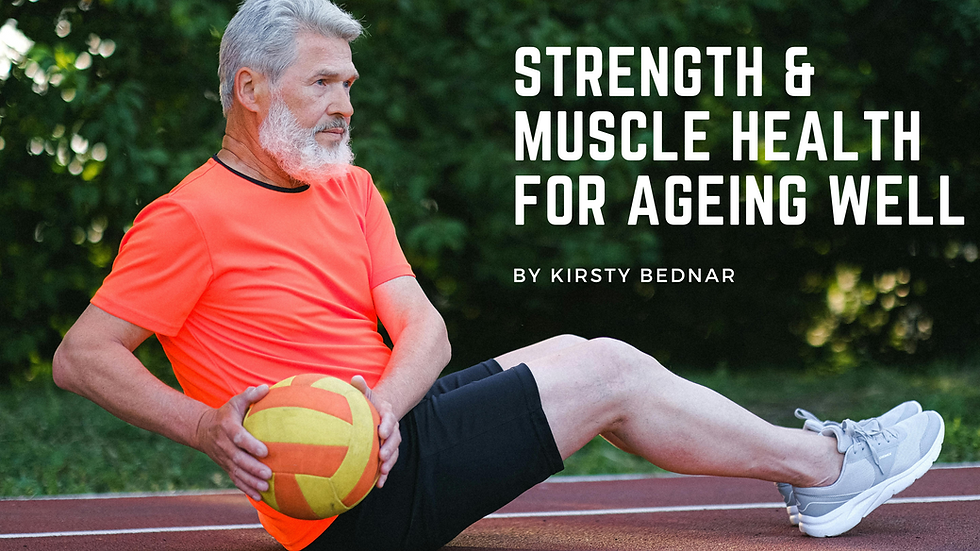Strength and Muscle Health: Your Anchor for Healthy Ageing
- Kirsty Bednar

- Aug 10
- 4 min read

If you're someone who values longevity and living life to the fullest as you move through your 30s, 40s and beyond, this blog post is for you! Building strength and keeping your muscle mass strong isn’t about aesthetics. It’s a foundation of mobility, mental resilience, and metabolic vitality that supports vibrant ageing. It’s what will allow you to play with your grandkids, tie your shoelaces, and move around freely when you are older, as well as now.
Why Aerobic exercise isn’t Enough
Walking, dancing, or cycling are fantastic for your heart and lungs—and should absolutely be part of your routine. But when it comes to preserving muscle mass and functional ability, walking alone just isn’t enough.
Aerobic activity doesn’t provide enough stimulus to preserve the type of muscle fibres that keep you strong, agile, and metabolically robust long term. That’s where resistance or strength-style training comes in: lifting weights or doing even simple bodyweight movements helps maintain muscle, support bone density, stabilise blood sugar and even boost brain health. As you can imagine these are all vital for healthy ageing.
Think of muscle as your body’s reserve tank: when it’s strong, you recover faster, you move better, and your metabolism runs efficiently even when you're at rest. If you lose too much muscle, everything from mobility to your immunity slows down and begins to malfunction.
Protein: Your Internal Muscle Builder
Strength training on its own only solves half the puzzle. Without enough protein throughout the day, your muscles don't get the building blocks they need to repair and grow.
After 40, most people need close to 1.0–1.2 grams of protein per kilogram of body weight, sometimes even more depending on activity level. That means a woman or man weighing around 70 kg may need a minimum of 70–80 grams of protein per day to maintain good strength and muscle.
Here's a look at a day of meals designed to support a strength-building routine:
Breakfast: Two eggs with sautéed spinach, alongside Greek yogurt topped with berries and seeds—roughly 30 g of protein to start your morning.
Snack: A handful of roasted almonds and some cheddar cheese— 10 g.
Lunch: A Grilled chicken breast salad with quinoa and plenty of vegetables—25 g protein
Snack: Half a can of sardines with cucumber slices or a serve of protein powder stirred into your milk of choice if you enjoy smoothies—about 20 g protein.
Dinner: Oven-baked salmon or lean red meat, roasted veggies and sweet potato or green beans—30 g protein or more depending on portion size.
This is around 90+ grams—covering the goal and supporting your muscle repair, daily movement, and metabolic health. I work with you in clinic to create dietary plans suited to you, so although it may seem overwhelming, I make sure it isn’t.
Functional Strength: Movement That Matters
Muscle training isn't all about gym equipment. Functional movement refers to exercises that mimic real-life actions. That includes stepping up onto curbs, lifting grocery bags, standing up from a chair without using your hands, or simply carrying toddlers, school bags or suitcases.
Incorporating this kind of movement two to three times per week helps your balance, coordination, posture, and confidence. Even better if it’s incorporated into your everyday life. It helps to preventing injuries by making your body more resilient, as well as naturally strengthening your muscles and balance.
Beyond Physical Strength: Why building Muscle Supports your Whole-Body Health
Injury Prevention and Independence: Strong muscles and core stability lower the risk of falls, fractures, and joint pain as you age.
Metabolic Support: Muscle tissue helps regulate blood sugar, burn fuel efficiently and stabilise appetite. This means more energy and better weight management for you.
Mood, Focus and Cognition: Physical strength training supports brain health, mood regulation and better sleep. Something we need at every age.
Consider strength training as your anchor to ageing well. It helps to improve your heart, mind, bone, muscle and metabolic health, which allows you to have more strength and independence for as long as possible. Let’s take a look now at what a longevity training plan could look like.
A Longevity Routine for Your 40s and Beyond
Here is what a week could look like in a longevity exercise plan:
150+ minutes of gentle aerobic activity over the entire week (walking, bikes, swim) broken into manageable chunks
Twice-weekly sessions of strength/functional movement
A spread of protein-rich meals and snacks each day that support muscle growth, repair and strength
Hydration, 7–9 hours of sleep, and mindfulness or stress management to boost your recovery. We discuss all of these in your clinic appointments to make sure you have all the information and support you need.
When you combine all of this together you’re investing in independence, mood stability, metabolic health and longevity for the long term.
Longevity support tailored to you
If you'd like to build a personalised strength and nutrition plan, please get in touch via my contact page. I will guide you on safe training options, nutrition & protein strategies and how to tailor everything to your life, personal preferences and health goals.
Muscle isn’t just for fitness—it’s the foundation of vibrant, resilient ageing and longevity. Let's build yours together.




תגובות